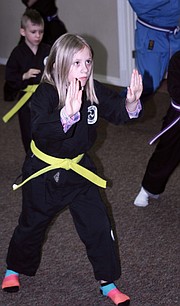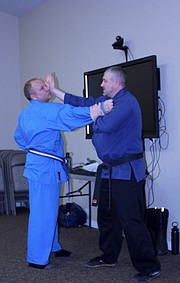Belts aplenty at Blue Heron Karate Academy
What does Shorin Ryu mean? It is a small forest school and it honors the Shaolin Kung Fu from China.
That is one of the questions and the response that all students are to know when they test for their next belt at the Blue Heron Karate Academy (B.H.K.A.). The academy is hosted and sponsored by the Clark Fork Valley Hospital in Plains. The youth students range in age from as young as five to 16 years, along with several adult students. There are 12 belt rankings, from beginner to the more advanced white, yellow, orange, purple with a white strip, purple, blue with a white stripe, blue, green with a white stripe, green, brown with a white stripe, brown, and black.
Currently there are four individuals who are half-way to their black belt ranking.
Jason William is the sensei of Blue Heron Academy. He has been training in martial arts since he was 12 years old. He holds a First Degree black belt in Shudokan Okinawan Karate, a Second Degree Black belt in Classic Okinawan Karate, a First Degree Black belt in Okinawan Kobudo (Traditional Weapons) and a First Degree Black belt in Matsumara Shorin Ryu. Williams has been teaching at Blue Heron Karate for the last two years. Lydia French and Chris Lyman are the assistant instructors at the B.H.K.A. The following skills are taught at the academy; discipline, character building, the value of hard work, goal setting, and realistic unarmed combat.
“We never use Karate training unless there is no other option and it is only as a defense of one’s self or family members,” Williams said. “Our Karate training motto here at the school is ‘Be the First with the Most’ and it is said when we bow at the end of every training session.”
The first training session is the Family Class, which begins with the students lining up and bowing first to the Shomen, who are the lineage of the instructors who have passed down the karate training, the second bow is to the sensei. After the respectful bowing has been completed, the sensei and students begin preparing for the class by doing a variety of stretches of the major limbs used in karate; hands, hips, feet, fingers, and head. Williams reminds the students of the importance of keeping themselves in good shape by stretching before any kind of karate.
The students demonstrated respect when several of their peers practiced doing a test, which involves introducing themselves, giving the name of their school, stating the name of their sensei, bowing, and then doing a Kata, a battle that takes place in the mind of the performer.
Williams praised the students as they practiced their test. He also demonstrated to the students what they should and should not do when they are either testing or at a karate tournament. Williams’ style of teaching involves using humor, many open-ended questions, and giving very clear verbal and visual demonstrations to his students. The students responded to his teaching and were often helping their peers if they appeared to be lost or confused when doing a move or a Kata.
The more advanced students meet for one hour after the Family Class. The advanced class is for those 16 years to adult, with some exceptions made for age and skill level of the individual. In the advanced class, the students worked on receiving extra training and will work with paddles or padded targets to hit, kick, or punch. Many of the moves in the advanced class involve learning and practicing combinations, which are three moves that will do more damage to your opponent and lessen the number of weapons they have to use against you.
In karate, the weapons used are the hands and feet. Williams reminded students of the head, feet, and then hands rule.
“First you look with your head, move your feet second, then your hands,” he said.
Williams and the advanced students practiced the Ridge Hand, which is a deceptive move and can confuse an opponent. The hand starts behind you and can be brought to the opponent as either a short range or long-range weapon.
Blue Heron Karate Academy’s Family class meets every Monday from 6-7:00 p.m. in the Clark Fork Annex Building number 2.
The more advanced class meets from 7-8:00 p.m. For more information about the Blue Heron Karate Academy, contact Jason Williams by email or by join their group on Facebook.
Reporter Douglas Wilks can be reached at dwilks@vp-mi.com or 406-826-3402.







